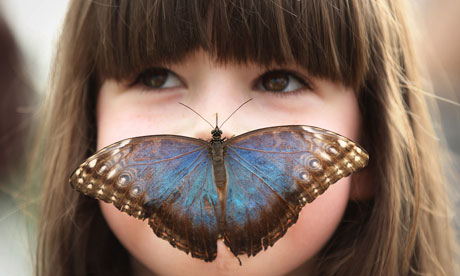A new exhibition reveals the astonishing habits of butterflies - including one that drinks a caiman's tears

The sandy-bottomed puddle in a tent on the Natural History Museum's front lawn in London does not look the most alluring of aphrodisiacs. But this shallow pool filled with an elixir of water, salts and minerals will be lapped up by hundreds of male butterflies eager to impress their mates.
Bundles of minerals extracted from the puddle will be presented to females, helping them lay more eggs in Sensational Butterflies, a new exhibition showing how these insects taste, smell, emit surprising squeaks - and are daring enough to drink the tears of a caiman.
The swallowtails, blue morphos and other live tropical butterflies will be joined for the first time at the museum by the common birdwing, a spectacular black-and-yellow creature and one of the largest butterflies in the world.
The very largest of the birdwings, the Queen Alexandra's Birdwing - named in honour of Queen Alexandra, wife of King Edward VII - is critically endangered, and could not be brought to the exhibition. Another birdwing caused Victorian entomologist Alfred Russell Wallace such excitement that he "felt much more like fainting than I have done when in apprehension of immediate death" when he first caught one, forcing him to retire with a splitting headache for the rest of the day.
Luke Brown, the manager of the butterfly house, said it was a great thrill rather than a headache to release the common birdwing into the exhibition after being satisfied for the first time that he could obtain specimens from a sustainable farm.
All the tropical butterflies in the museum's butterfly house are bred from common species in their country of origin including Belize, Costa Rica and parts of Africa and Asia. Their chrysalises are packed in cotton wool and flown to Britain, whereupon Brown and his colleagues painstakingly glue each one to a branch in the hatchery.
Visitors can then watch the butterflies struggle from their chrysalises, slowly pump up their crumpled wings and take flight.
"I love butterflies because they always tickle," said Sabina O'Harvey, aged 5, one of a group of children from Nightingale primary school in Hackney given a preview of the exhibition, which opens on 12 April. "One landed on my nose and it was ticklish. They were all beautiful."
"I like all of them. I like them when they fly on to my hand, and I like them when they drink," said six-year-old Hannah. "I'd like them in my home. I'm going to get two and I'm going to feed them every day."
Obsessed with butterflies ever since he walked into a butterfly house as a six-year-old 30 years ago, Brown admitted he still struggles to comprehend the wonder of metamorphosis, and the fact that in as little as one week caterpillars break down and rebuild themselves into butterflies.
"To create a completely different creature from this biological gloop is just a natural wonder of the world," he said.
The exhibition reveals there is more than just the miracle of metamorphosis in a butterfly's life. Scientists are still learning how butterflies use their senses and communicate with each other through sight, smell and sound.
Butterflies feed off blood, sweat and tears. Although there are no live butterflies or moths that feed on blood at the museum, there are some tear-drinkers, including Dryas iulia, which will deliberately plunge its proboscis in the eye of a caiman to irritate it and cause it to produce tears, which it then drinks.
As the exhibition reveals, butterflies taste with their feet, patting leaves to establish if they are suitable for laying their eggs on. Butterflies can see more colours than any other animal and the exhibition allows visitors to experience what it is like to see through a compound eye.
In the butterfly house, visitors can crawl through a tunnel as if they were caterpillars becoming a butterfly and listen to the strange noises emitted by pupae. If disturbed, some pupae will squeak loudly, a defensive mechanism to scare off potential predators.
The exhibition reveals that the noisiest butterfly is the cracker butterfly, which makes its cracking sound to communicate with others as well as to warn off predators.
Blue morpho butterflies, which are flying in the exhibition, have ears at the base of their wings which, when magnified, look a bit like fried eggs. A scientist is currently investigating whether these ears are used to detect prey: the spectacular morpho is often eaten by bats.
Among the first visitors were children who were amazed to learn that lemons grow on trees, while several said they had never seen a butterfly in the wild or in their parks or gardens at home.
For some, however, the miraculous sensory powers of butterflies were a bit alarming. Samuel Jacob, five, concluded: "I think they're scary."